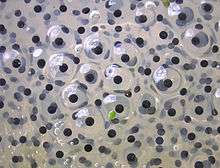Matrotrophy
_(21057027940).jpg)
Matrotrophy is a form of maternal care during animal development, associated with live birth (viviparity), in which the embryo of an animal or flowering plant is supplied with additional nutrition from the mother (e.g. through a placenta). This can be contrasted with lecithotrophy, in which the only source of nutrition for the embryo is yolk originally contained within its egg.
While commonly associated with vertebrates and especially mammals, matrotrophy occurs in 21 of 34 animal phyla.[1]
In plants, matrotrophy is considered a critical evolutionary development preceding the origin of embryophytes and therefore essential to the evolution of land plants.[2] Matrotrophy is facilitated by cytological and ultrastructural modifications on one or both sides of the generational junction, a region called the placenta.[3] Specialization of the placental cells pertains further to their cytological and ultrastructural characteristics: the cytoplasm is often dense and rich in lipids, the vacuole is typically reduced but large in Sphagnum, the endoplasmic reticulum extensive, mitochondria numerous and large, chloroplasts numerous, often less differentiated, rich in lipid-filled globuli and sometimes filled with starch.[3]
See also
References
- ↑ Ostrovsky, Andrew N.; Lidgard, Scott; Gordon, Dennis P.; Schwaha, Thomas; Genikhovich, Grigory; Ereskovsky, Alexander V. (20 April 2015). "Matrotrophy and placentation in invertebrates: a new paradigm". Biological Reviews. doi:10.1111/brv.12189. Retrieved 30 April 2015.
- ↑ Graham, L.K.E. & Wilcox, L.W. (2000). "The origin of alternation of generations in land plants: A focus on matrotrophy and hexose transport.". Philosophical Transactions of the Royal Society of London, B. 355: 757–67.
- 1 2 Ligrone, R., Duckett, J.G., Renzaglia, K.S. (1993). "The gametophyte-sporophyte junction in land plants.". Advances in Botanical Research. 19: 231–317.
- Goffinet B, Et al. 2009. Morphology and classification of Bryophyta. In Bryophyte Biology 2nd ed. Cambridge University Press.
